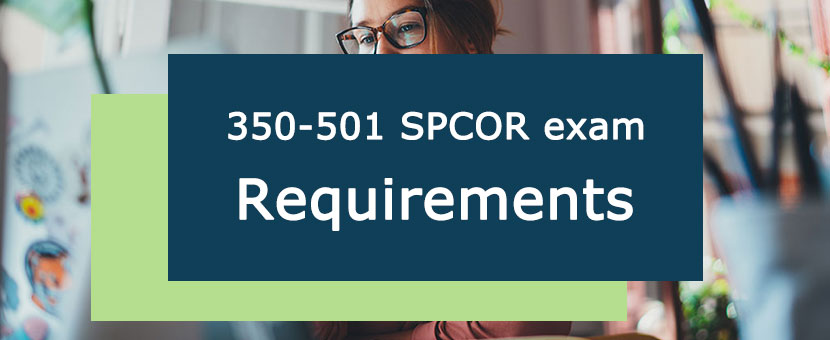
For network professionals aiming to advance in the Service Provider (SP) field, the Cisco 350-501 SPCOR certification serves as a crucial milestone. It’s not only the core exam of the CCNP Service Provider track but also a strong validation of one’s ability to implement, operate, and troubleshoot complex SP network infrastructures.
Holding the SPCOR certification proves your competence in areas such as routing, automation, MPLS, security, and programmability.
According to Global Knowledge’s salary survey, certified Cisco SP professionals earn on average 18% more than their non-certified peers.
Why Leads4Pass 350-501 Dumps Stand Out
The Leads4Pass 350-501 dumps (https://www.leads4pass.com/350-501.html) are meticulously curated and verified by Cisco-certified experts. The material fully aligns with the latest Cisco Exam Blueprint v1.1 and includes 568 verified real exam questions and answers.
These dumps cover all major SPCOR topics:
- Network Architecture and Design
- Routing Technologies (OSPF, BGP, IS-IS)
- MPLS and Segment Routing (SR-MPLS, SRv6)
- Service Provider Security
- Network Automation and Programmability (NETCONF, RESTCONF, YANG, Python)
Leads4Pass regularly updates its question bank in sync with Cisco’s official revisions, ensuring candidates always study the most current and relevant content.
2025 Latest 350-501 Exam Trends
As of Oct 2025, Cisco has implemented several notable updates to the SPCOR exam:
- Increased focus on SRv6 and MPLS SR integration scenarios;
- New question types emphasizing automation scripting and Python/YANG usage;
- Reduced weight on traditional QoS topics — replaced by automation and telemetry-based monitoring.
The Leads4Pass team has already updated the dumps accordingly, helping candidates prepare confidently for the latest version of the exam.
How to Prepare Efficiently with Leads4Pass 350-501 Dumps
Step 1: Review the Official Exam Topics
Start from Cisco’s Exam Topics page to understand module weights.
Step 2: Follow a 30-Day Study Plan
- Days 1–10: Review Routing and MPLS basics
- Days 11–20: Deep dive into SRv6 and SP Security
- Days 21–30: Take 350-501 VCE mock exams, track errors, and reinforce weak areas
Step 3: Combine Theory with Practice
Don’t rely solely on memorization — pair the dumps with Cisco documentation, whitepapers, and DevNet Labs to understand the reasoning behind each answer.
Step 4: Practice in a Lab Environment
Use Cisco Modeling Labs (CML) or GNS3 to build hands-on configuration experience and troubleshooting skills.
Two Study Modes Provided by Leads4Pass
| Version | Key Features | Best For |
|---|---|---|
| Offline access, printable notes | Theory learners | |
| VCE | Real exam simulation, timer & score tracking | Practical candidates |
Using both modes together helps you grasp core concepts while building real exam confidence.
Leads4Pass also provides free sample questions and supports mobile viewing, making it ideal for on-the-go learning.

Latest Cisco 350-501 dumps exam questions and answers:
| Number of exam questions | Type | Related |
| 15 | Free | Cisco CCNP |
Question 1:
A network engineer is configuring a BGP route policy for the SUBNET prefix set. Matching traffic must be dropped, and other traffic must have its MED value set to 400 and community 4:400 added to the route. Which configuration must an engineer apply?
A. router-policy CISCO if destination in SUBNET then drop
else
set med 400
set community (4:400) additive
endif
end-policy
end
B. router-policy CISCO if destination in SUBNET then
drop
endif
set med 400
if community mathces-any SUBNET then
set local-preference 400
set med 500
set community (4:400) additive
endif
end-policy
end
C. router-policy SUBNET if destination in SUBNET then
drop
endif
set med 400
set local-preference 400
if community matches-any SUBNET then
set community (4:400)
endif
end-policy
end
D. router-policy SUBNET if destination in BGP then drop
else
set med 400
set community (4:400)
endif
end-policy
end
Correct Answer: A
Question 2:
Refer to me exhibit.
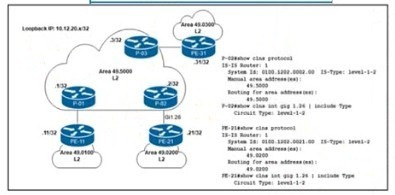
A network engineer notices PE-21 convergence degradation due to the growing LSDB size of Level 2 areas in the network The engineer decides to migrate router PE-21 from an inter-area design to an intra-area implementation, inter-area routing must De accomplished via an ATT-bit set by the Level 1/Level 2 router. Which configuration must the engineer implement on PE-21 to complete the migrate?
A. configure terminalrouter isis 1 no net 49.0200 net 49.5000 is-type level-1-2end
B. configure terminalrouter isis 1 net 49.5000.0100.1202.0021.00 is-type level-1-2end
C. configure terminalrouter isis 1 net 49.5000.0100.1222.0022.00 is-type level-1end
D. configure terminalrouter isis 1 no net 49.0200.0100.1202.0021.00 net 49.5000.0100.1202.0021.00 is-type level-1end
Correct Answer: D
Question 3:

Refer to the exhibit. Over the last few months, ISP A has doubled its user base. The IT Director asked the engineering team to monitor memory consumption and buffer statistics on all P and PE devices in the MPLS core. Most devices have CPU usage of 70% or more, so the solution must be targeted and secure. Which two commands must the engineering team implement on P and PE devices to meet these requirements? (Choose two.)
A. snmp-server enable traps memory bufferpeak
B. snmp-server host 192.168.101.1 version 1 community1 auth memory
C. snmp-server enable snmp-traps community1 bufferpeak
D. snmp-server host 192.168.101.1 version 2c community1 memory
E. snmp-server host 192.168.101.1 version 3 auth community1 memory
Correct Answer: AB
Question 4:
DRAG DROP
Drag and drop the descriptions from the left onto the corresponding OS types on the right.
Select and Place:
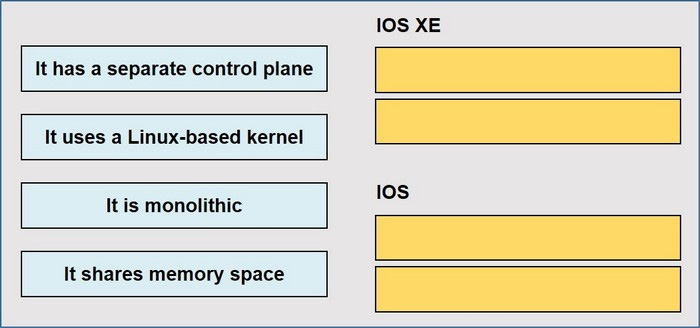
Correct Answer:
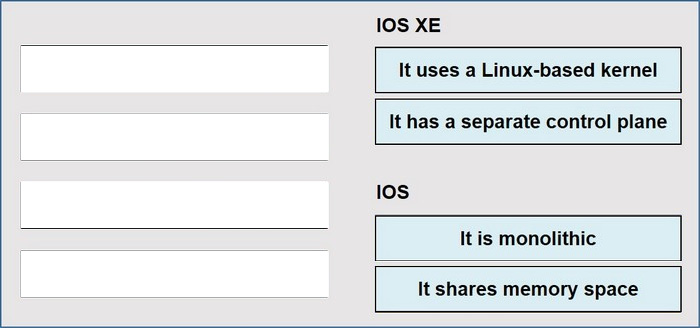
IOS XE: It uses linux-based kernel It has a separate control plane IOS: It is monolithic It shares memory space
Question 5:
Refer to the exhibit.

An engineer configured BGP summarization on a customer\’s network. Which route is advertised to BGP peers?
A. 192.0.0.0/16
B. 192168.0.0/16
C. 192.168.1.0/24
D. 192168.0.5/30
Correct Answer: B
Question 6:
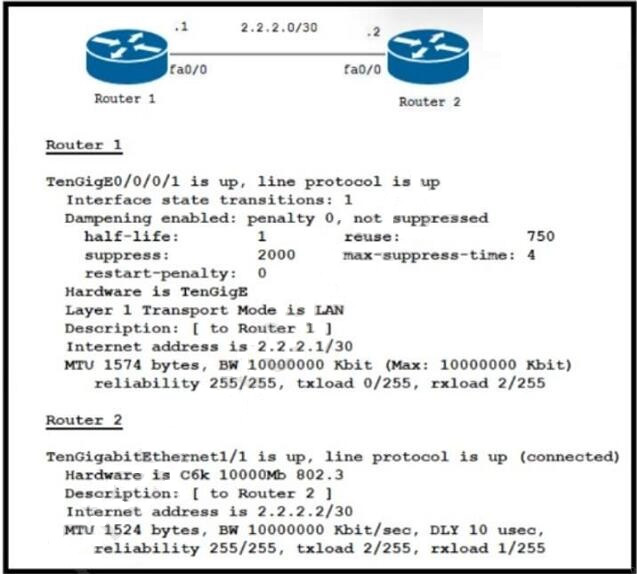
Refer to the exhibit. Router 1 and Router 2 were installed in the data center Router 1 is the core router in the network, but it fails to establish an OSPF peering with Router 2, and customer traffic is unable to pass. Router 1 also reports an increase in CPU and memory usage. However, the CPU for R2 is stable. Which action resolves this issue?
A. Change the MTU to 1524 on Router 1.
B. Disable Cisco Express Forwarding on Router 2.
C. Change the transport mode to WAN on Rooter 1.
D. Enable MPLS on Router 2.
Correct Answer: A
Question 7:
A network architect dides to expand the scope of the multicast deployment within the company network the network is already using PlM-SM with a static RP that supports a high-bandwidth. video-based training application that s heavily used by the employees, but excessive bandwidth usage is a concern.
How must the engineer update the network to provide a more efficient multicast implementation\’?
A. Configure IGMP to manage the multicast hosts on each LAN
B. implement BSR to support dynamic RP notification.
C. Deploy ICMP to Improve multicast reachability across the network using static RP.
D. Implement STP to improve switching performance for multicast data.
Correct Answer: B
Question 8:

Refer to the exhibit. A company recently deployed a new network using OSPF in the core to share routes. The network administrator selected OSPF as the routing protocol because of its ability to maintain a route database. When the new network was started up, all routers booted normally, but the link between routers R1 and R2 failed to come up. The two routers are located in the same rack at the data center. Which task should an engineer perform to correct the problem?
A. Synchronize the dead timers.
B. Change one of the OSPF router IDs so that the router IDs are in different subnets
C. Change the OSPF process ID on one of the devices so that the two IDs match
D. Configure the MTUs on the interface to match.
Correct Answer: D
Question 9:
A router is advertising multiple networks to its BGP neighbor in AS 5200 with peer IP address 1.1.1.1. Which configuration must be applied so that the router permits updates only for networks with a prefix mask length less than or equal to 21?
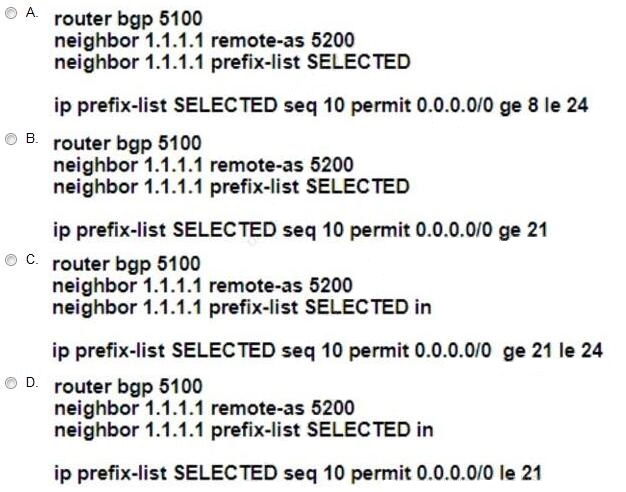
A. Option A
B. Option B
C. Option C
D. Option D
Correct Answer: D
Question 10:
How can shared services in an MPLS Layer 3 VPN provide Internet access to the Customers of a central service provider?
A. Static routes on CE routers allow route leakage from a PE global routing table.
B. The CE router can establish a BGP peering to a PE router and use the PE device to reach the Internet.
C. The customer VRF uses route targets to import and export routes to and from a shared services VRF.
D. Route distinguishers are used to identify the routes that CEs can use to reach the Internet.
Correct Answer: C
Question 11:
How does Cisco MPLS TE use OSPF extensions to allow for optimized transit between a headend router and a destination router?
A. Router LSAs share router link advertisements to each router within the MPLS environment so that tunnels can be built bidirectionally.
B. ASBR Summary LSAs share OSPF domain information so that the two routers know how to reach each other during tunnel setup.
C. Network LSAs share RSVP information to build the tunnel between the two routers.
D. Opaque LSAs calculate and establish unidirectional tunnels that are set according to the network constraint.
Correct Answer: D
Explanation:
Cisco MPLS TE uses OSPF extensions to allow for optimized transit between a headend router and a destination router by utilizing Opaque LSAs.
Opaque LSAs allow for the calculation and establishment of unidirectional tunnels that are set according to the network constraint.
The tunnels are built bidirectionally by utilizing Router LSAs, which share router link advertisements to each router within the MPLS environment.
ASBR Summary LSAs are also used to share OSPF domain information so that the two routers know how to reach each other during tunnel setup. Furthermore, Network LSAs are used to share RSVP information which is necessary for setting up the tunnel between the two routers.
Question 12:
Which capability does the MPLS TE FRR facility backup protection method provide?
A. creating a bypass LSP for each protected LSP at each point of local repair
B. assigning a backup TE LSP tunnel to the protected node at the headend of the protected TE LSP
C. leveraging label stacking to protect selected TE LSPs using a single backup TE LSP
D. defining the set of characteristics for the backup TE LSP
Correct Answer: A
Question 13:
Refer to the exhibit.

Tier 2 ISP A on AS 653 is connected to two Tier 1 ISPs on AS 321 and AS 51 respectively. The network architect at ISP A is planning traffic flow inside the network to provide predictable network services. Cisco Express Forwarding is disabled on the edge router. How should the architect implement BGP to direct all traffic via the Tier 1 ISP with next-hop 7.4.5.2?
A. Implement the BGP routing protocol and run the bgp deterministic-med command.
B. Implement MP-BGP with a 4-byte AS number with the bgp best path compare-routerid command.
C. Implement the BGP routing protocol and the maximum-paths 2 configuration.
D. Implement BGP route-reflector functionality with the bgp always-compare-med configuration.
Correct Answer: A
Question 14:
Refer to the exhibit.
mpls label range 16 100000 static 100002 1048570mapls label protocol 1dp
mpls 1dp gracetal-restartinterface Loopback0! ip address 10.20.20.20 255.255.255.255no ip directed-broadcastno ip mroute-cache! interface Gi1/1/0ip address 10.12.0.2 255.255.0.0no ip direted-broadcastmpls label protocol ldpmpls ip ! router ospf 100log-adjacency-changesnsf cisco enforce globalredistribute connected subnets network 10.20.20.20 0.0.0.0 area 0 network 10.12.0.0 0.0.255.255 area 0 ! mpls ldp router-id Loopback0 force
A network administrator implemented MPLS LDP changes on PE-A LSR device. The engineer must ensure there are no LDP peer are fully operational. Which LDP feature must the engineer apply to the existing configuration to eliminate the problem?
A. Configure MPLS LDP IGP synchronization on the network.
B. Configure MPLS LDP NSR for all LDP sessions.
C. Enable LDP session protection under the routing protocol.
D. Disable IP CEF on routers running LDP and enable LDP.
Correct Answer: B
Explanation: https://www.cisco.com/c/en/us/td/docs/ios-xml/ios/msp/configuration/xe- 3s/mp-ha-xe-3s-book/mp-nsr-ldp-supp.pdf
Question 15:
Refer to the exhibit.
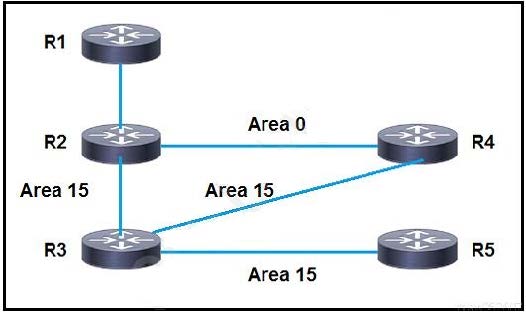
An engineer has started to configure a router for OSPF, as shown.
Which configuration must an engineer apply on the network so that area 15 traffic from R5 to R1 will prefer the route through R4?
A. Implement a sham link on the link between R3 and R2 to extend area 0 over area 15.
B. Implement a multiarea adjacency on the link between R2 and R4, with the cost manipulated to make the path through R4 preferred.
C. Place the link between R3 and R5 in a stub area to force traffic to use the route through R4.
D. Increase the cost on the link between R2 and R3 to a value higher than the link between R2 and R4, to influence the path over R3 and R4.
Correct Answer: B
Explanation:
After doing an easy lab I can say for certain that the answer is B. To add some more information to clarify, R3 wil ALWAYS prefer the INTRA-area link to R2, no matter the cost assigned to the interface. So it is until the inter-area 0 link between R2-R4 is configured as multiarea also in area 15, that the cost of the interface comes into play.
…
Frequently Asked Questions (FAQ)
Q1: Are Leads4Pass 350-501 dumps identical to the real exam?
A: They follow the exact logic and structure of the official exam, offering comprehensive topic coverage.
Q2: How often are dumps updated?
A: Monthly, based on Cisco’s latest SPCOR blueprint changes.
Q3: What should I study first?
A: Begin with MPLS and Segment Routing before moving to Automation and YANG models.
Q4: What’s the pass rate using these dumps?
A: Over 97% of users pass the SPCOR exam on their first attempt.
Q5: Does it include mock exam features?
A: Yes, the VCE version includes a full exam simulator with timing and error review.
Career Path After Earning 350-501 SPCOR
Once you’ve achieved the SPCOR certification, you can continue toward advanced SP exams, such as:
- 300-510 SPRI (Service Provider Routing Implementation)
- 300-515 SPVI (VPN Technologies)
- CCIE Service Provider Lab Exam
These advanced certifications pave the way for roles such as Network Architect, Infrastructure Consultant, or Service Provider Engineer at ISPs and large-scale enterprises.
The Smart Path to Passing SPCOR
In today’s rapidly evolving networking world, relying solely on fragmented study materials is no longer enough.
The Leads4Pass 350-501 dumps combine expert-reviewed content, continuous updates, and proven accuracy — giving you everything you need for a confident SPCOR exam experience.
👉 Download now: https://www.leads4pass.com/350-501.html
Get the latest PDF or VCE version and start your high-efficiency SPCOR study journey today.